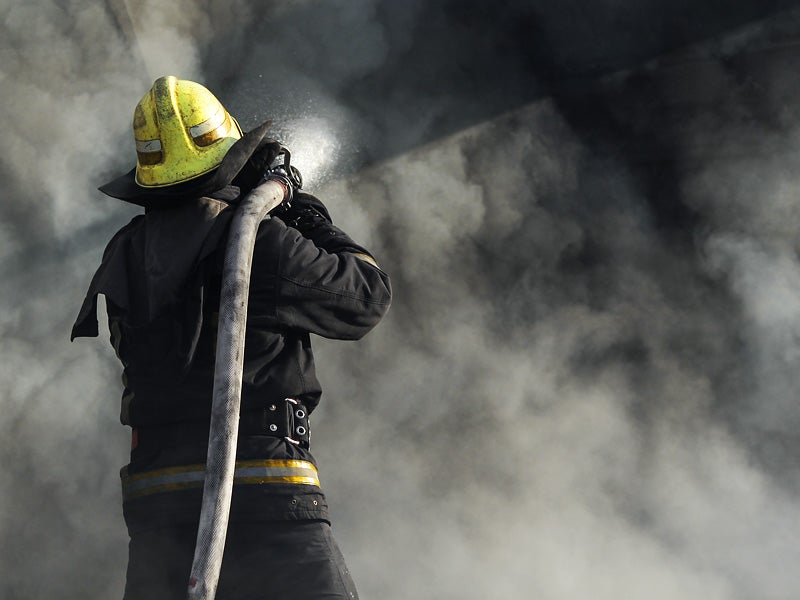Coalition Seeks Ban on Flame Retardants
Health, firefighter, consumer and science groups are calling on the Consumer Product Safety Commission to ban certain consumer products if they contain any organohalogen flame retardants—a class of chemicals that counts dioxins and the pesticide DDT among its ranks.

This page was published 10 years ago. Find the latest on Earthjustice’s work.
Is there anything more primal than the fear of fire?
The chemical industry has exploited that fear for decades to boost sales of toxic flame retardants by convincing manufacturers that we need to protect ourselves by putting these chemicals in a wide array of household products from chairs to nursing pillows to the plastic casing around electronic products (like televisions and laptops that are doused in flame retardants before they’re sold to the public).
For many years the tobacco industry aided this effort by opposing protections that would require cigarettes to be self-extinguishing. Why did these two very different industries team up? The tobacco industry didn’t want to change the way it made cigarettes—even to make them safer. With flame retardant chemicals added to household items, Big Tobacco could claim that smoking does not increase fire risks.
The chemical industry’s deceptive practices and partnership with Big Tobacco were documented in a landmark investigative series by the Chicago Tribune two years ago. But not enough attention has been paid to the health consequences of loading furniture and other household items with toxic chemicals.
We fear trace amounts of pesticides on our food, while sitting on sofas containing pounds of similarly toxic chemicals. These chemicals migrate out of our sofas and other household products and are released into the air in our homes. As a result, 97 percent of U.S. residents have measurable quantities of toxic flame retardants in their blood.
Low-income communities and communities of color bear a higher burden from these chemicals than others.
But most people simply aren’t aware of the health risks posed by these toxic chemicals that have been linked to reproductive impairment, neurological impacts including learning deficits and decreased IQ in children, endocrine disruption, cancer and immune disorders.
Children are at particular risk because, as every parent knows, kids touch everything and are constantly putting their hands in their mouth. This means they ingest a lot of chemicals that migrate from products soaked with flame retardants. It also means that they may be exposed during critical developmental windows of rapid growth and brain development during which they are particularly vulnerable to these toxins; and children’s products in particular are likely to contain flame retardant chemicals.
As studies prove one type of organohalogen flame retardant dangerous, a handful of states have banned it or threatened a ban. The chemical industry has responded to these bans by replacing the chemical with a structurally similar flame retardant that is likely just as harmful, leading to what public health experts call “regrettable substitutions.” For example, after pentaBDE was banned by many states, it was replaced with chlorinated tris, a chemical that was recently found by the state of California to be a “known carcinogen.”
As Deborah Rice, a former U.S. Environmental Protection Agency (EPA) toxicologist who works for the Maine Center for Disease Control and Prevention, told the Chicago Tribune:
By the time the scientific community catches up to one chemical, industry moves on to another and they go back to their playbook of delay and denial.
Yet, because of the failures of the Toxic Substances Control Act (TSCA)–a federal statute that is supposed to assure that chemicals don’ t pose unreasonable risks to families and communities–EPA has not regulated organohalogen flame retardants despite the strong scientific evidence about the health risks posed by this chemical class.
In the face of serious human health risks and inaction by EPA, a broad coalition of organizations, including the International Association of Fire Fighters, American Academy of Pediatrics, Consumers Union, Consumer Federation of America, National Hispanic Medical Association, American Medical Women’s Association, League of United Latin American Citizens, Learning Disabilities Association of America, Worksafe, Kids in Danger and the Green Science Policy Institute has just submitted a legal petition to the Consumer Product Safety Commission (CPSC). These groups are asking for regulations banning four categories of consumer products–children’s products, furniture, mattresses and the casings around electronics–if they contain any organohalogen flame retardants.
Learn more about the risks you face from these toxic flame retardants, and stand with our well-respected partners as we ask the Obama Administration’s CPSC to protect us and our children from being poisoned by products that we use every day.
This blog first appeared on The Huffington Post on April 16, 2015.
Earthjustice’s Toxic Exposure & Health Program uses the power of the law to ensure that all people have safe workplaces, neighborhoods, and schools; have access to safe drinking water and food; live in homes that are free of hazardous chemicals; and have access to safe products.